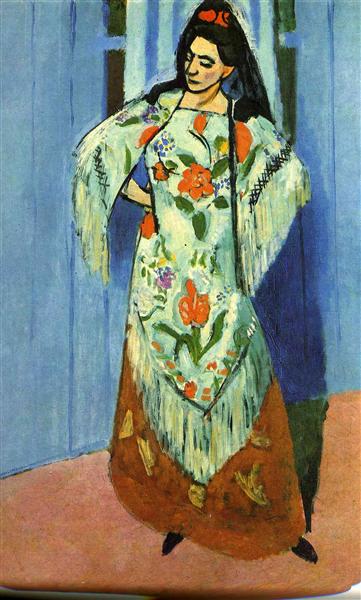Description
The work "Manila Shawl" by Henri Matisse, created in 1911, is a vibrant and evocative representation that encapsulates several distinctive characteristics of the French artist, highlighting his mastery in the use of color and composition. From an immediate visual inspection, one can notice how Matisse masterfully combines simplicity and splendor through a bold color palette and the staging of a Manila shawl, an object that embodies elegance and the exoticization of cultural elements in Western art.
Matisse's "Manila Shawl" is primarily characterized by its symphony of harmonious colors, where the shawl itself, with its rich shades of red, blue, and black, unfolds against a background that exquisitely contrasts with the lighter tones surrounding it, as can be seen in the painting's image. This combination of colors is not accidental; Matisse is known for his philosophy that color could have an almost autonomous emotional force, a principle that is clearly revealed in this work.
Although "Manila Shawl" does not explicitly feature human figures, the object itself—the shawl—recreates an almost anthropomorphic presence, emitting a sense of life and movement. Matisse had an extraordinary ability to infuse vitality into inanimate objects, endowing them with an energy that transcends mere physical representation. The floral patterns and intricate texture of the shawl unfold with a fluidity that almost hints at a breathing being behind the embroidered threads.
The subtle details in the execution of the shawl also speak to Matisse's fascination with Eastern culture and the way these influences permeated his work. This interest was part of a broader trend of orientalism that prevailed in early 20th-century European art, where Eastern art was not only a source of inspiration but also a way to challenge and expand the boundaries of Western aesthetics.
Moreover, it is relevant to note the historical context in which Matisse created this work. By 1911, the artist had already established himself as a key figure in Fauvism, a movement that embraced the use of vibrant color and the simplification of forms to convey emotion and essence. "Manila Shawl" not only reflects the ideals of Fauvism but goes further by incorporating decorative elements with a deeply pictorial and sensory sense.
Reviewing other contemporary works to "Manila Shawl," such as "The Dance" and "The Music," one can observe a pattern in Matisse's quest to achieve purity in form and color. In this phase of his career, he dedicated himself to perfecting the interaction between background and figure, color and form. However, "Manila Shawl" stands out for its focus on a singular object and its ability to create a visual narrative that transcends the simplicity of its composition.
Ultimately, "Manila Shawl" is a work that shines in Matisse's canon for its ability to fuse exoticism and intimacy, color and form, in such a way that each element of the painting contributes to a powerful visual and emotional experience. The work is not only a testament to Matisse's technical skill but also to his profound sensitivity towards the object as a source of beauty and meaning.

